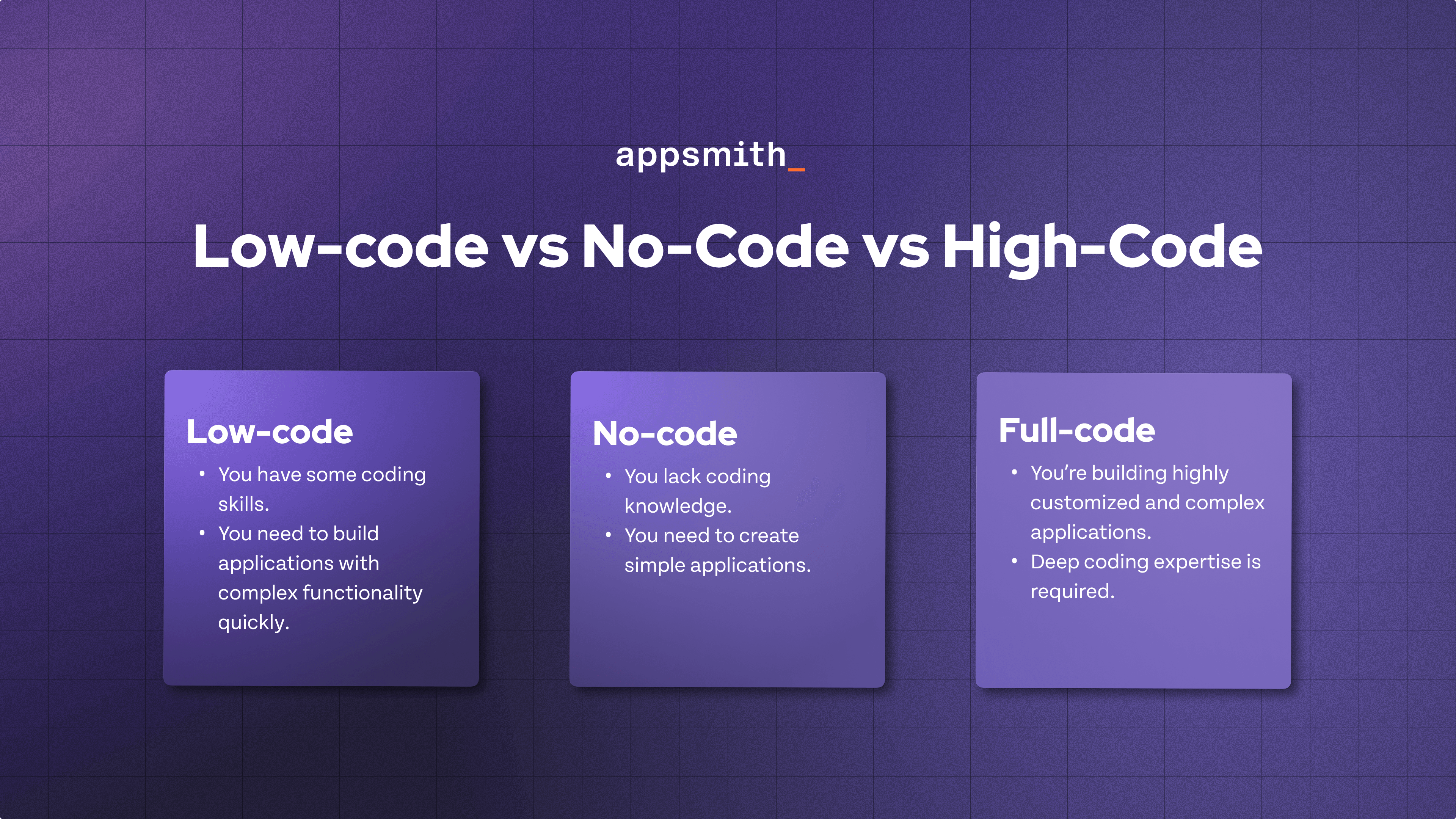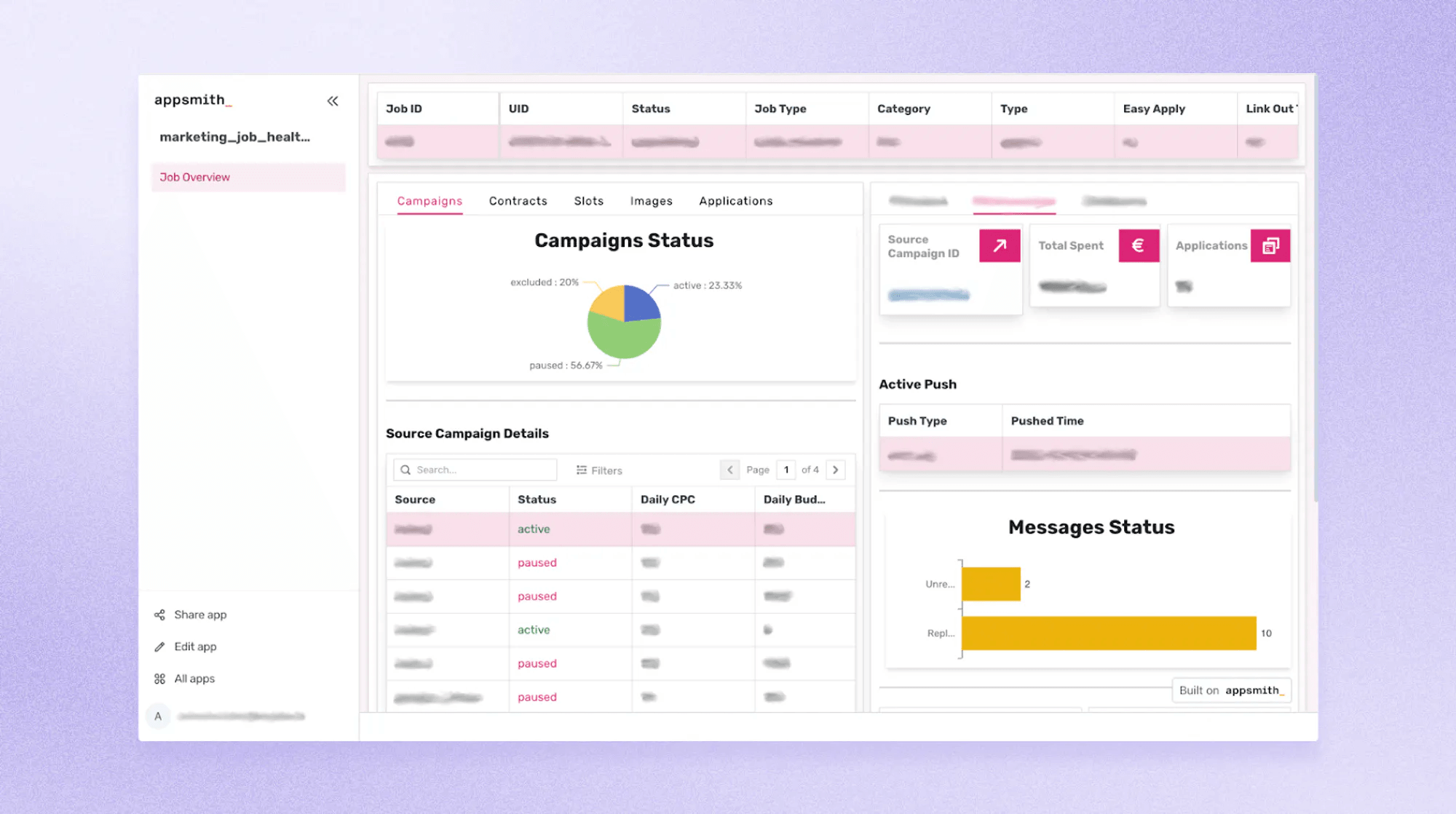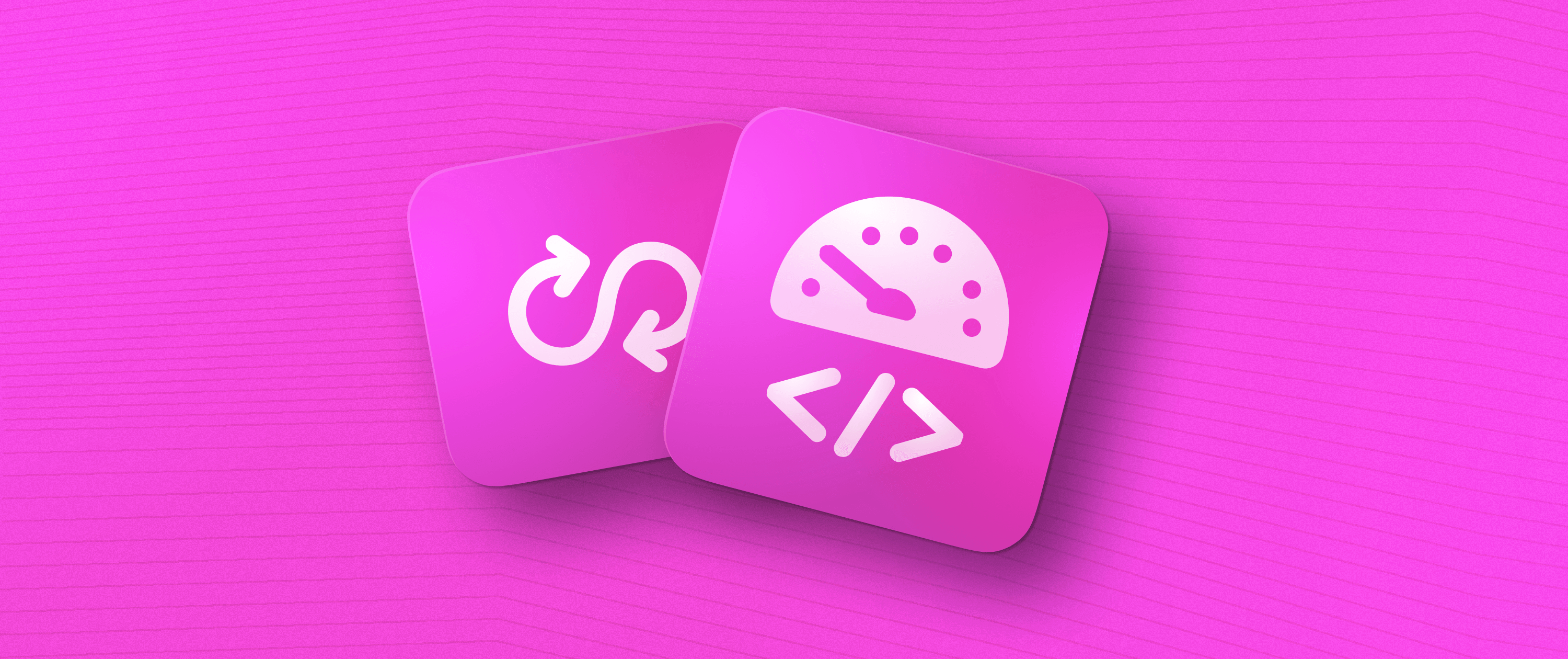
What is The Difference Low-Code vs No-Code?
What is The Difference Low-Code vs No-Code?

The adoption and implementation of low-code and no-code platforms are on the rise, allowing businesses to significantly reduce the time and expertise required to develop applications. At the same time, they can respond to their needs more quickly and efficiently. The decision between low-code and no-code will depend on the specific requirements of your project.
This article provides a comprehensive understanding of the differences between low-code and no-code development platforms. It explains their unique characteristics, use cases, pros and cons, and gives insight into when to use each type of platform.
What is low-code?
Low-code is a modern approach to software development. It employs visual interfaces with intuitive drag-and-drop features. This makes low-code development platforms (LCDPs) user-friendly for both developers and non-developers.
LCDPs often include integration features. These streamline the process of incorporating existing databases and services into new applications.
Low-code platforms democratize the software development process in two ways. First, they equip professional developers with pre-built templates, reusable components, and automation features. This reduces the need for repetitive tasks. Second, they allow citizen developers – those without formal coding knowledge – to participate actively in the app development process.
These platforms also frequently provide significant flexibility and customization options. Developers can meet specific business needs and implement custom features that may not be available by default within the platform.
What is no-code?
No-code platforms simplify the application creation process even more. They allow applications to be created without any coding. They work similarly to low-code platforms, using visual development environments. With drag and drop application components to design and build their applications.
These platforms are especially beneficial for business users and professionals who may not have any formal coding knowledge. They empower these users to create apps to solve their own problems or meet their individual requirements. They bridge the gap between business needs and software solutions.
There are several popular no-code app platforms available. Some examples include Softr, Airtable, Bubble, and Webflow.
What is the difference between low-code and no-code?
The primary distinction between low-code and no-code platforms is their complexity level and the required technical skill set.
Characteristics of low-code platforms
Low-code platforms are designed to speed up the development process. They use visual interfaces with simple logic and drag-and-drop features, reducing the need for extensive coding languages. However, some coding knowledge is still necessary for intricate customization and functionality.
For instance, a business might opt for a low-code tool like Appsmith for building internal tools swiftly and efficiently.
A company could use Appsmith to develop a customer support 360 app. This app would help the sales team track customer interactions, manage leads, and analyze sales data. It could integrate with existing databases and offer features specifically tailored to the company's unique needs. However, writing JavaScript may be required for customization due to the highly specific nature of support processes and policies.
For example, a company might have a complex lead scoring system or a unique process for handling customer complaints. To accurately mirror these unique business logics within the app, custom JavaScript code would need to be written within widget properties, queries, or other settings.
Characteristics of no-code platforms
No-code platforms enable anyone to create applications, regardless of their technical expertise. They rely on visual development environments where users can design and build their applications by dragging and dropping application components.
For instance, a business might opt for a no-code platform like Bubble when they need to create a simple internal tool quickly, without many users, and without any coding. Here's an example:
Consider a HR department within a company. Even without coding knowledge, any HR team member could use Bubble to develop a basic employee directory app. This app would allow HR personnel to easily add, view, and manage employee information. Thus, no-code capabilities make the app development process accessible to all HR team members, irrespective of their technical abilities.
Low-Code | No-Code | |
Target Audience | Professional developers: Full-stack developers, back-end developers, data engineers, head of IT. | Citizen developers: Operations managers, marketing managers, sales representatives, product managers, business consultants. |
Use Cases | Internal tooling like dashboards, reporting tools, and CRUD apps. Workflow automation, data management and integration tools, custom CRMs, custom support tools, and other apps with complex functionality. | Web apps like marketplaces or eCommerce stores. Simple internal tooling, dashboards, and other simple applications that don’t require coding knowledge. |
Features | Drag-and-drop interfaces, ability to write custom code, extensible via APIs, reusable pre-built components, widgets, and templates. Version control and role-based access control, environments, flexible deployment options, CI/CD capabilities. | Drag-and-drop interfaces and WYSIWYG editors, pre-designed templates and widgets, simple automating workflows, pre-configured connectors without coding requirements, one-click deployment options, simple user management interfaces, built-in analytics. |
Benefits | Speed up the development process compared to traditional software development methods. Offer robust security features, scalability options to handle increasing numbers of users, the capacity to process larger volumes of data or transactions, or the flexibility to add more features or functionalities as the business needs evolve. And customization capabilities to meet specific business needs. | Simplicity of app creation, as no coding is required. Accessibility to non-technical users, allowing people without coding skills to create apps. Speed of development. Cost-effectiveness for creating simple applications. |
Cons | Some coding knowledge required, may have limited functionality. | Lacks flexibility for complex apps, limited customization. |
When to use low-code, when to use no-code, and when to full-code?

Low-code and no-code platforms can be more cost-effective, especially in the short term. They need less time and fewer resources to develop applications, saving on labor costs. However, they might have ongoing subscription fees. This applies particularly to closed-source platforms and those with user-based pricing.
Full-code development might need a larger initial investment, especially if hiring experienced developers. Once the application is built, there are usually no ongoing platform subscription fees like there can be with low-code or no-code platforms. But maintenance and scalability can be costly in the long run.
No-code platforms may be suitable for very small projects, specifically those that involve simple apps and only one or two users. However, for larger projects, the responsibility often shifts to development or IT teams, even if the project was initially started by business users.
Developers taking over the management of a no-code app can be less than ideal. This is because no-code tools often lack the required flexibility for deployment and customization that developers need. This can make the process more complicated and less efficient than anticipated.
Here are a few questions that you can ask yourself in order to pick:
Question | No-Code | Low-Code | Traditional Development |
What is the complexity of the application I want to build? | Suitable for simple applications with no plans to scale in the mid-to-long term | Suitable for moderate and high-complexity apps, depending on the capabilities of the platform and app requirements | Suitable for high complexity applications |
Do I have any coding expertise or resources available? | Not required | Some coding expertise | Required |
How much time do I have to develop this application? | Fastest for non-coders, but may slow developers due to the complexity of visually building business logic. | Faster than traditional development | Takes the most time |
What is my budget for this project? | Small-budget projects. | Small- to medium-budget projects. | Large-budget projects. Most likely customer-facing. |
Does the platform need to integrate with any existing systems or applications? | Limited integrations, may rely on pre-built connectors and third-party integration tools | Supports integrations with pre-built connectors and APIs. Greater flexibility in creating custom integrations | Supports extensive custom integrations. Allows to direct access and manipulation of databases and develop custom APIs |
What kind of support does the platform provide? | Basic support is available in free plans, while more personalized support is included in paid tiers | Basic support is available in free plans, while more personalized support is included in paid tiers. | Depends on the development team |
How scalable is the platform? | Limited scalability | Scalable, but depending on the platform, may not handle extremely high loads | Highly scalable |
How important is customization for my project? | Limited customization | Moderate and high customization | High customization |
What are the security provisions of the platform? | Basic security features | Enhanced security features | Depends on the development team, can implement extensive security measures |
How to choose a low-code platform?
If a low-code platform suits your business needs, consider these aspects when choosing the best one:
Understanding your needs
First, identify the type of application you want to develop and the required functionality. Consider:
The purpose of the app
The app's users
The required features
The need for integration with an existing software or system
For example, if you're creating an internal tool to manage customer data, you might need a platform that can integrate with your existing CRM. It should handle a large volume of data and be accessible for anyone, including those with limited technical abilities.
Customization
Look at how much customization the platform allows. A more flexible platform lets you tailor the app to better fit your business processes. Check the platform’s documentation about customization features and the ability to write custom code or extensible APIs. Reading case studies can also help to understand other customers’ experiences.
For example, if you want to develop a project management tool, you may have specific workflow processes unique to your operations. A flexible low-code platform would allow you to customize the project management tool to mirror these unique processes.
Integration
Check if the platform can integrate with your existing systems and applications. Consider the ease of setting up the integration, as some platforms have built-in connectors for popular software. Also, verify the platform's data handling during integration to ensure it meets security standards.
For example, if you're using Salesforce as your CRM and want to use a low-code platform to build a customer support app, you need to check if the platform can easily connect to Salesforce, securely transfer customer data, and update records in real-time.
Scalability
The platform should be capable of supporting your application as it grows in complexity and usage. It should handle an increase in user load without a drop in performance and manage increasing volumes of data.
Also, as your app evolves and becomes more complex with the addition of new features or workflows, the platform needs to be flexible enough to accommodate these changes. It should also allow for easy scaling of the underlying infrastructure.
Pricing
Understand the pricing structure of the platform, considering both the immediate and long-term costs. Some platforms may have low upfront costs but require ongoing subscription fees. Consider how the pricing scales with the size and complexity of your apps.
Check if there are costs associated with integrating with other systems or for additional support services.
Support, Community and Resources
Choose a platform that offers robust support, including accessible and responsive assistance. An active community can provide peer-to-peer help, which might be stronger in open-source platforms.
Also, consider if the platform provides various format resources, such as detailed documentation, tutorials, videos, and guides.
Security
When considering the security aspects of a platform, look at how it handles data protection, user access control, and compliance with regulatory standards.
For example, a self-hosted environment gives you complete control over your data, its storage, and security measures. This can lead to improved data security and compliance. However, with this increased control comes increased responsibility for maintaining security protocols and updates.
Appsmith - a low-code platform for businesses
Appsmith is an open-source, low-code platform that simplifies the process of building business applications. Its user-friendly features, such as drag-and-drop widgets and a wide range of data sources, allow you to quickly create your first application.
Low-code platforms such as Appsmith offer significant flexibility and a developer-like workflow, making them an attractive choice for businesses looking to improve their software solutions.
They make it possible to quickly and efficiently develop proof-of-concepts and full-fledged applications, significantly cutting down on development time and enabling collaboration between engineers and non-engineers. This speeds up the process of adding new features and improving user experience, while maintaining the flexibility needed for sophisticated business logic.
Success story - HeyJobs modernizes legacy apps with Appsmith

As HeyJobs grew, they encountered issues with their legacy applications. Their existing admin panel, built on Ruby on Rails and Active Admin, didn't scale well and lacked flexibility. This led to high development costs and efforts.
To overcome these challenges, HeyJobs turned to Appsmith. The low-code platform facilitated efficient development of new features and decreased the reliance on engineers. Appsmith helped HeyJobs rebuild their legacy applications, which automated budget allocation for enterprise clients. This transition resulted in a faster and more intuitive user experience and significantly reduced development time.
Anton, the Head of Marketing Engineering at HeyJobs, explained the benefits of using Appsmith:
"All that layering logic is handled by the application. It's replaced by drag and drop, the visual editor, widgets, and components. You don't have to build them from scratch. The only thing that you have to do is write standalone JavaScript functions within certain components to extend or customize the standard functionality, which is a significant time saver."
Choosing between low-code and no-code depends on your project needs
The decision between low-code and no-code ultimately depends on the specific requirements of your project, including the complexity of the application, the available resources, and the necessary level of customization. It's crucial to understand your needs and evaluate the features of the platforms before making a decision.
If you've determined that a low-code platform is what you need, you can easily get started for free using Appsmith.

